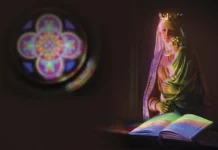The Gospel does not specify which of these birds were offered. The Holy Spirit thus gives us to understand that one way should not be preferred to the exclusion of the other, since both are pleasing to God.
The always-succinct verses of Sacred Scripture contain an ocean of meaning, into which we can immerse ourselves to discover the wonders enclosed in so few words.
We encounter this characteristic particularly in the passages describing the life of the Holy Family. The vast supernatural realities these sections hold have served as the basis and inspiration for numerous distinguished authors to commit to writing what grace has spoken in their souls.
If we were to put together all that they have related over the ages, how many libraries could be filled! Let us note, however, that there still remains much to be studied in future centuries, for regarding the life of Jesus among us, “the world itself could not contain the books that would be written” (Jn 21:25).

As we are in the month of February, one passage especially draws our attention: the account of the Presentation of the Child Jesus in the Temple and the Purification of Mary, related in St. Luke’s Gospel. Commentators offer some very beautiful reflections by analysing the most diverse aspects of the event, but in this article we will focus only on one significant detail.
The Law ordered the poorest couples to offer at least “a pair of turtledoves, or two young pigeons” (Lk 2:24) as a sacrifice to the Lord. And it is no accident that these two birds were prescribed.
St. Cyril explains that the turtledove is the more loquacious of the two and the pigeon the meeker.1 Our Lord wished to symbolize in this way that He would practise on this earth the most perfect meekness and would make His harmonious voice resound, to draw the world to His merciful Heart.
St. Bede, in turn, reflects on the virtues that these birds represent: the pigeon, simplicity; the turtledove, chastity.2 If the turtledove should lose its mate, it will not go in search of another. Thus, in the first days of His life on earth, Christ wished to show a predilection for the virtue of purity by means of these two little creatures.
Another beautiful symbol is the fact that, as the pigeon is gregarious, it represents the active life, while the turtledove, because it lives alone, evokes contemplation. However, this isolation, together with its loquacity, make it the image of preaching and confession of faith.3 Both modes of life were practised by our Saviour and lead, each in its own way, to human sanctification.

St. Bede4 also points out that these two animals, by their habit of cooing, express the lamentations of the Saints on this earth. The turtledove symbolizes the hidden tears of prayer; the pigeon, living in flocks, is the figure of the public prayers of the Church.
St. Luke does not say in his Gospel whether the animals offered to the Lord by the Holy Family were turtledoves or pigeons… In this way, according to St. Bede, the Holy Spirit gives us to understand that we should not give preference to the contemplative life to the exclusion of the active, or vice versa, since the two ways are pleasing to God and we ought to follow both.5

Nevertheless, let us bear in mind that the turtledoves or pigeons offered for the Child Jesus, before being delivered into the hands of the priest, rested in the hands of the Patriarch St. Joseph and fell under the serene gaze of the Virgin Mary. This invites us to desire to live always under the custody and support of this most holy couple, for in this way our existence, though poor in merits and virtues, will be a most pleasing offering of adoration and praise. ◊







